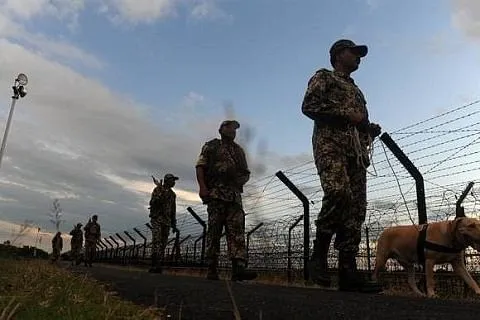North Hill, LoC (Keran): The infiltration through the Keran sector has become difficult and it can be gauged by the Anti Insurgency Obstacle System (AIOS) existing along the Line of Control (LoC).
North Hill is one of the most important posts of the Army involved in tackling infiltration in the Keran sector. It is situated at an altitude of 12,000 feet above sea level and located at the strategically important Rangi-Sadhna Road.
The post is home to a small but highly equipped group of soldiers who keep a close watch on the movement of intruders 24×7.
“Here we are involved in round-the-clock duty,” one of the officers heading the post told a group of selected journalists. “This is LoC and extra vigil is needed here.”
A soldier at the post said, “We have to maintain a 24×7 surveillance and ensure no one crosses the LoC. Even though there is a ceasefire, we don’t let our guard down as terrorists have never stopped attempting to sneak into Kashmir.”
The officer as well as soldiers said that they were maintaining a tight vigil along the LoC to ensure peace in Kashmir.
Besides, Anti Insurgency Obstacle System (AIOS), the soldiers are equipped with night vision devices, integrated surveillance systems, and a very robust deployment.
“We believe the rate of infiltration across LoC has dwindled due to the robust anti-infiltration grid,” they said. “We will see an upswing in the number of attempts being made as we approach through the autumn towards winter.”
Keran till yesteryears was one of the traditional routes for infiltrators.
From here all infiltration routes converge at the mighty Shamasabari range and then onwards to the hinterlands of Kupwara, Baramulla, Sopore, and Bandipora in north Kashmir.
The Army seems to have been able to bring down the infiltration, knowing well that it was impossible to ensure zero infiltration given the nature of the 743-km long LoC in J&K that passes through mighty peaks, rugged mountains, thick forests, and even freshwater streams.
The officers and soldiers also opine that there is no rest despite India and Pakistan agreeing on a ceasefire.
“We don’t take chance and lower the guard,” they said.
However, they said that the ceasefire had helped.
“The Pakistani Army would usually try to provide cover to the infiltrators by firing at the Army posts when there was no ceasefire. That is there. But, ceasefire or not, we have to be alert. We can’t take it for granted,” the officer said.
There has been a decline in the attempts from across the LoC over the last few years.
According to officials, in 2017, the infiltration attempts made were 419.
The number was 328 followed by 216, 99, and 77 in 2018, 2019, 2020, and 2021.
This year the number of infiltration attempts is also not high.







